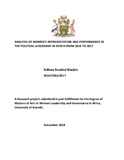| dc.contributor.author | Wanjiru, Ndikwe Rosalind | |
| dc.date.accessioned | 2019-01-16T06:50:51Z | |
| dc.date.available | 2019-01-16T06:50:51Z | |
| dc.date.issued | 2018 | |
| dc.identifier.uri | http://hdl.handle.net/11295/104816 | |
| dc.description.abstract | Globally, women under-representation in political sphere remains a concern in achieving gender balance in political representation and decision making. Increasing trend of African women leaders’ entry into the political space has been noted with some of the African countries achieving over 33% in political leadership. Despite Kenyan women being on the frontline promoting this discourse, they continue to be under-represented in the political arena for almost a decade after the gender sensitive and progressive new constitution was adopted in August 2010. This study investigates and analyses the patterns of women representation and performance in political leadership in Kenya after the new constitution was promulgated. The research was guided by Feminist Political Theory and Critical Mass Theory using document review methodology of relevant secondary sources from 2010 to 2017. The study established that despite increased participation in politics, women under-representation continues to persist at the national assembly level with 23% representation. However, critical mass thresholds have been achieved at the county level, with 34% women representation due to adherence with the 2/3 gender rule which enabled nominations at the county to increase the number of women political leaders. Despite women being under represented at the national assembly they sponsored 12% of total Bills from 2013 to 2016. Their performance and impact has progressed as they gain access to and experience in political leadership. Performance assessment at the county level remains a challenge due to difficulties with accessing relevant data. The study recommends that women’s representation in political sphere is paramount with at least 30% critical mass threshold. The state progress and prosperity depends on an inclusive
v
leadership with diverse players. Therefore the government of Kenya should ensure the constitutional provision on 33% gender principle is implemented to actualize the critical mass in all political levels | en_US |
| dc.language.iso | en | en_US |
| dc.publisher | University of Nairobi | en_US |
| dc.rights | Attribution-NonCommercial-NoDerivs 3.0 United States | * |
| dc.rights.uri | http://creativecommons.org/licenses/by-nc-nd/3.0/us/ | * |
| dc.title | Analysis Of Women’S Representation And Performance In The Political Leadership In Kenya From 2010 To 2017 | en_US |
| dc.type | Thesis | en_US |



